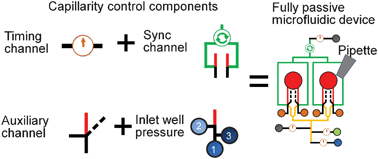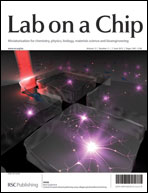Preprogrammed capillarity to passively control system-level sequential and parallel microfluidic flows†
Abstract
In microfluidics, capillarity-driven solution flow is often beneficial, owing to its inherently spontaneous motion. However, it is commonly perceived that, in an integrated microfluidic system, the passive capillarity control alone can hardly achieve well-controlled sequential and parallel flow of multiple solutions. Despite this common notion, we hereby demonstrate system-level sequential and parallel microfluidic flow processing by fully passive capillarity-driven control. After manual loading of solutions with a pipette, a network of microfluidic channels passively regulates the flow timing of the multiple solution menisci in a sequential and synchronous manner. Also, use of auxiliary channels and preprogramming of inlet-well meniscus pressure and channel fluidic conductance allow for controlling the flow direction of multiple solutions in our microfluidic system. With those components orchestrated in a single device chip, we show preprogrammed flow control of 10 solutions. The demonstrated system-level flow control proves capillarity as a useful means even for sophisticated microfluidic processing without any actively controlled valves and pumps.


 Please wait while we load your content...
Please wait while we load your content...